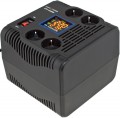Power
The maximum active load power allowed for this model.
Active power is the power that in AC appliances is spent on useful work or on heat generation. In addition to it, such devices also consume reactive power — it goes to the operation of specific components, primarily capacitors and inductors. Apparent power, denoted in volt-amperes (kilovolt-amperes), is the sum of active and reactive, see below about it. Here we note that in simple everyday situations, there is enough data on active power indicated in watts for calculations. In particular, it is this parameter that is considered the key when choosing stabilizers
for washing machines and
dishwashers : in the first case, power from 2 to 5 kW is considered optimal, in the second — from 1.8 to 2.5 kW.
Anyway, the total active power of the connected load should not exceed the figures indicated in the characteristics of the stabilizer. For a full guarantee, it's ok to take a certain margin, but this margin should not be too large — an increase in the allowable power significantly affects the dimensions, weight and price of the device. Also note that there are formulas that allow you to convert the active power consumption into total power, taking into account the type of connected electrical appliance; these formulas can be found in special sources.
Power
Maximum apparent load power allowed for this model
In electrical engineering, full power is called, which takes into account both active and reactive power; the first type of power is discussed above, and the second can be described as the effect of windings, inductors and capacitors on the operation of AC networks. Apparent power is the main parameter for calculating loads on equipment in professional electrical engineering; it is usually denoted in volt-amperes (VA), in the case of stabilizers — in kilovolt-amperes (kVA). Note that for convenience, different types of power in electrical engineering are denoted by units with different names. That is why the power in W indicated in the characteristics of the stabilizer is usually not equal to its power in VA.
When choosing a stabilizer for some household appliances, it is quite enough to have active power data, but if possible it is better to use the full one. In particular, it is this parameter that is key when looking for
a stabilizer for a refrigerator or
a stabilizer for a boiler : in the first case, 0.4 – 1 kVA is considered the optimal value, in the second — from 0.1 to 0.7 kVA. However, anyway, it is necessary to choose a specific model in such a way that its total power is not lower than the total power of the entire connected load — and it is better to have a reserve (in case of unforeseen circumstances or connecting additional eq
...uipment). At the same time, note that powerful models are distinguished by large dimensions and weight, and most importantly, high cost; therefore, it does not always make sense to chase the maximum numbers.
Also note that there are formulas that allow you to derive the optimal total power of the stabilizer based on data on active power and type of load; they can be found in special sources.Grounded sockets
The number of
sockets for 230 V with grounding provided in the design of the stabilizer.
Some electrical appliances, such as refrigerators and washing/dishwashers, must be grounded when connected. This point should not be ignored — there is a risk of a serious electric shock. Accordingly, the number of sockets with grounding corresponds to the maximum number of such devices that can be simultaneously connected to the stabilizer without the use of splitters. At the same time, ungrounded devices can also be connected to such sockets.
Carrying handle
The presence in the design of the stabilizer of a special
handle for carrying the device from place to place. This feature is useful primarily for powerful and, accordingly, heavy devices, which would be inconvenient to hold directly by the case. And in the most "weighty" models, which are not designed to be carried alone, there are several handles.

